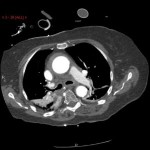 Few places have taken the wisdom of crowds quite to heart as much as the medical profession. I’ve documented a number of resources and communities that have been created to provide a place for professionals and patients alike to seek help and support for their queries.
Few places have taken the wisdom of crowds quite to heart as much as the medical profession. I’ve documented a number of resources and communities that have been created to provide a place for professionals and patients alike to seek help and support for their queries.
Undoubtedly one of the more interesting of these communities is Radiopaedia. The site, which bills itself as a Wikipedia for radiologists, is a veritable treasure trove of x-rays, MRI scans and other explorations of our innards.
The site was built in 2005 by Australian radiologist Frank Gaillard with the aim of providing professionals with a substantial database of all manner of scans. What started as a simple Wiki type site has grown to be much more interactive. It’s common now for instance for professionals to upload a patients scan and seek a 2nd opinion on their diagnosis.
Whilst the knowledge sharing between qualified professionals is undoubtedly interesting, arguably more powerful again is the use of sites such as Radiopaedia by students. WikiDoc leads the way in this regard with their crowdsourced medical textbook, but many other sites are emerging to make learning medicine a more social experience, not to mention of course a more cost effective experience.
The challenge for the site will be to ensure it retains its educational value and doesn’t descend into an embarrassing bodies style freak show. The Radiopaedia Twitter account for instance typically attracts many more shares than it does actual attempts at diagnosing the photos.
With any community of course, there are bound to be teething problems as they figure out the best way to achieve their objectives. Overall though, the site is another positive step in improving knowledge sharing in the healthcare profession. With industry costs showing few signs of reducing anything that can help professionals do more with less has to be a good thing, so Radiopaedia is broadly speaking a force for good.